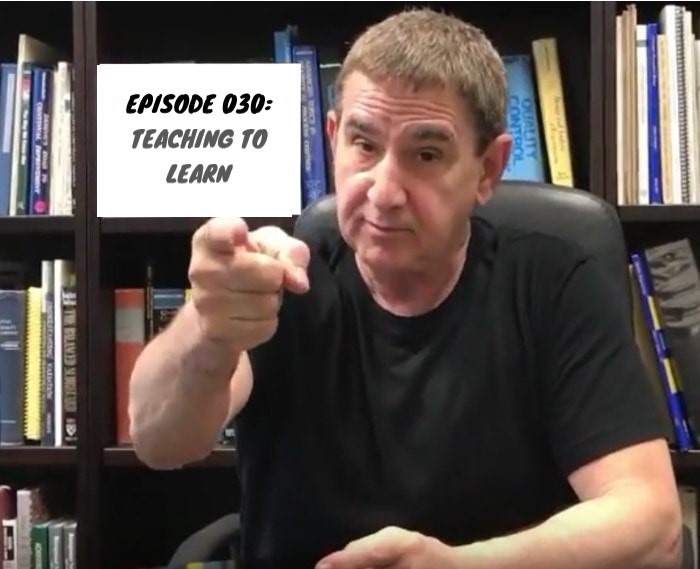This is Why Teaching to Learn is the Best Way to Learn!
This week’s video discusses a great way to learn.
Teaching to learn is one of the best methods to learn a subject. Research shows this is extremely effective.
I am reminded of an old story about two professors walking from one building on campus to another. The first said, “Do you know about the newest advancements in genetics.? The second answered, “No, I haven’t taught it yet.”
The point of the story is a great way to learn is to teach.
As a matter of fact, research has shown that people who learn to pass a test, learn far less than people involved in teaching to learn.
Use It or Lose It to Make It Actionable – Teaching to Learn
When teaching to learn:
 Decide what you want to learn by teaching.
Decide what you want to learn by teaching.
 Figure out what you don’t know about the subject and fill in any missing blanks.
Figure out what you don’t know about the subject and fill in any missing blanks.
 Find your students.
Find your students.
 Think about questions they might ask, and be prepared to answer them.
Think about questions they might ask, and be prepared to answer them.
When to Use It:
 Use teaching to learn whenever you want to learn something new and be sure you really understand it.
Use teaching to learn whenever you want to learn something new and be sure you really understand it.
What Do You Think?
 What are you excited about teaching to someone else? If you’ve ever learned something while teaching, tutoring, or training someone, post in the comments below!
What are you excited about teaching to someone else? If you’ve ever learned something while teaching, tutoring, or training someone, post in the comments below!
Until next time, keep teaching, behave and as always…Prime Your Pump!
–Howie
If you enjoyed this post, it would mean the world to us if you shared it with people you care about via any of the social media platforms below!
Popular Previous Posts:
This is Why You Need to Be Careful Using Others Experiences
How to Remove These 7 Wastes From Your Life
3 of the Best Podcast Episodes I Have Ever Heard!
You’re Fired! 10 Things This Mofo Learned By Getting Fired
This is How to Make a Great First Impression Every Time!


This is so true. I learned so much as a teacher because as you say you have to have a full understanding of a topic before you can teach it and be fully prepared to explain it so that it is easily understood by all the students . Attaching a story or anecdote to the subject makes it more meaningful and memorable for both the student and teacher. Thank you.
Good video Howie. I’ve heard variations on the chauffer story before. The concept works, I have learned so much in preparing for lectures. An example – – I was giving a slide show presentation to a group of Civil War historians. One portion dealt with the Union’s attempts to restore government services to the southern states, such as mail delivery, as I own an envelope sent in June 1865 from Maryland (Union) to Richmond, Virginia (former Confederate). So I decide to investigate the envelope further. And this is what I found, somewhat condensed here (thanks google) –
1) The envelope’s postmark (Point Lookout) came from a town that contained a large prisoner of war camp holding Confederate soldiers. It was the postmark that caused me to buy the envelope.
2) The person addressed had previously served in the Confederate army, but had left after completion of his enlistment time. This former soldier’s brother had been captured in battle just 3 days before the surrender at Appomattox. Because he had been captured, he became a prisoner of war sent to Point Lookout, and therefore not eligible for the pardons issued by Grant to the surrendering members of the Army of Virginia.
3) The prisoner had died the same date as the envelope’s postmark. I concluded that the envelope contained a death notice sent to the prisoner’s brother.
4) The post-war memorial obelisk at Port Lookout includes the prisoner’s name as having died in the camp.
So I prepared power point slides showing the envelope, an in period lithograph of the Point Lookout prison, copy of the official Union Army report describing transport of captured Confederates to Point Lookout, photos of the obelisk monument and the brass plaque on the side with the prisoner’s name.
This portion of the lecture generated the most interest, with questions and comments like “how did you find out all this info” – “what attracted you to this envelope” – “what a difference 3 days makes”. I later wrote up this information for publication in a historical research journal. If you would like a copy, I can email it to you.
All because of one envelope.
Now back to my latest research project, my family links to the Stewarts, the royal family of Scotland.